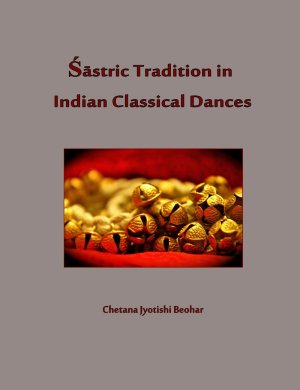
|  |

|  |
"Sastric Tradition in Indian Classical Dances" - Shanta Serbjeet Singh e-mail: shanta.serbjeetsingh@gmail.com March 25, 2015  Chetna Jyotishi Beohar is a Kathak dancer, an aesthete, an administrator of the arts and an avid scholar. Her new book Sastric Tradition in Indian Classical Dances published by Agam Kala Prakashan, deserves notice for all these reasons as well as the singular one that she is well versed in both classical dance Kathak, as well as Sanskrit. Dance studies suffer from two factors—limited pedagogical knowledge of the tools of research coupled with little or no proficiency in different languages. The dance scholar who has knowledge, say of Kathak, as well as of Persian and Urdu, besides Sanskrit, Hindi and English can definitely contribute original insights into the impact of political forces such as the changes in cultural history that accompanied the advent of the Moguls in the medieval period. Chetna Beohar has research and publication of many books on Kathak to her credit. Add to it proficiency in Sanskrit and you have the right foundation for some original insights. Chetna covers a lot of ground, drawing on Bharata's Natya Shastra, Bhavaprakasanam and Sangita Ratnakara. From types of auditoriums recommended by Bharata to the kind of rituals to be observed in their building, not just by the architect but even by the priest who sanctifies the space, as well as the day and the time to be chosen for the consecration, Bharata's approach is obviously holistic and fused into Vedic philosophy. Here we have evidence, if one were needed, of the multi-disciplinary approach of the ancient thinkers. Auditoriums were required for a very practical concern, to save the actors that were to provide leisure and entertainment to the citizenry and protect them from the vandalism of the "daityas," the demons! Sounds familiar? Much like the anti-terrorism measures observed these days, the ancients fused their security concerns with the need to enlist the harmonious support of the planets, the energies of the solar system and indeed of the entire cosmos! Here, I would like to take up another dance book, a translation from the original in Sanskrit into English of a text on Bharatanatyam by a Telugu scholar who takes the story of our dance, fed by so many streams, several centuries ahead from Bharata. The author Jayasenapati is a dance lover, curiously one who was also a professional military general of the Kakatiya kings whose rule of 300 years, from 11th to 14th centuries, left an incredible imprint on the cultural history of peninsular India. A handsome and neatly brought out publication, the duo who have also translated it into English, Dr. Pappu Venugopala Rao and Dr. Yashoda Thakore, have made the book very reader-friendly by interspersing the original verses in Sanskrit into both Roman English and an interpretation in English. They also pay attention to the phonetic as well as transliteration aspect of the original. But while dance scholarship is the aim of a labour of love like this, coupled, I imagine with service to Andhra pride, signalled by the support of the ONGC, one is left hungry for a more pan-Indian understanding of the life and times of Jayasenapati and the Kakatiya dynasty he served or the social, economic and political forces working in the period it flourished in. After all, a fine art like classical dance does not work or prosper in isolation of the other factors which matter in society. Specially, the absence of any related work on how people thought, felt and wrote about the arts at that time. Jayasenapati's Nrtta Ratnavali is a dance treatise and it sticks to its ambit, of course, giving us a profile of both classical and folk dance techniques used at that time. However, one does yearn for insights into Andhra's social history and its epigraphical and anthropological context. While comparative analysis of ancient texts is best left to scholars, certain facts that even a lay reader can glean, jump out of the text. For instance, that the word nrtya does not find any mention in the Natya Shastra. The terms nrtta, nrtya, natya, tandava are used loosely by many non-lakshana writers. But finally, through first Nandikeswara and then Jayasenapati and his compatriot Sarngadeva, the author of Sangita Ratnakara (there was only a ten year time difference between them) clarity begins to emerge. It is not as if they agree on the definition of nrtya. Dr. Rao says that Nandikeswara defines nrtya as rasabhava vyanjanadi yuktam, but all the others drop the word rasa. For the lay person, it is only pertinent to remember that while the term may not be mentioned by Bharata, the concept of nrtya is inherent in his treatise. Jayasena gives explicit definitions for all the three terms, nrtta, nrtya and natya. In passing, and this is mentioned by me because the subject of devadasis is of topical interest, the Kakatiya dynasty has left behind ample epigraphical and sculptural evidence of their generous gifts of land and precious objects to artistes. An inscription of Dharmasagara talks about land donations to ten devadasis and the arrangements for them and fourteen musicians to perform in the temple. The 1,000 pillar temple at Warangal is of great importance to the study of Nrtta Ratnavali, by itself an inspiration for the writing of the treatise. If Dr. Venugopala Rao's book is a delight to peruse for all its production values, Dr. Beohar's work highlights the problems faced by the serious scholar who, ideally should be left to pursue her work without worrying about how it will finally get to the reader. Typos lie scattered throughout "Sastric Traditions…" and despite the best efforts of the writer, act like the irritants they are. Thank God for the insights that come from her own experience and extensive training in Kathak. Beohar points out that a bhava is called as such because it leads to bhu, a rasa arising out of different kinds of acting. Just as a variety of materials, when assembled together, produce a distinct flavour so does a bhava arise through distinctive techniques of acting. There can be no rasa without a bhava and there can be no bhava without rasa. Just as a skilled assemblage of aromatic spices, condiments and herbs make a dish tasty. Just as from a seed grows a full fledged tree, out of a tree a flower, out of a flower a fruit, so does rasa become the seed of all (sthayi) bhavas and lead to the joy that a spectator experiences. Bhava, rasa -just two words out of thousands which we try to translate into English and actually believe we manage to make them convey the sense, essence and nuance of what Bharata Muni wrote more than 2000 years before a shepherd from Nazareth became the milestone for a new marker - Anno Domini, signpost of a new language of life and discourse!.  Shanta Serbjeet Singh, for twenty-five years, columnist, critic and media analyst for The Hindustan Times, The Economic Times and The Times of India, is the recipient of the Lifetime Achievement Award of the Sangeet Natak Akademi and Delhi Govt.'s Sahitya Kala Parishad for her contribution to the field of culture. She just finished her term as Vice Chairman of the SNA, is the founder-secretary of the World Culture Forum and continues as Chair of the UNESCO created NGO APPAN (The Asia-Pacific Performing Arts Network), a position to which she was appointed in 2001. Singh has authored several well-known publications such as 'Indian Dance: The Ultimate Metaphor' (published by Ravi Kumar (Paris), 'The 50th Milestone: A Feminine Critique' (Sterling Publishers, to mark India's fiftieth anniversary of Independence), 'Nanak, The Guru' (Oxford University Press) and 'America and You' (22 editions). Post your comments Pl provide your name and email id along with your comment. All appropriate comments posted with name and email id in the blog will also be featured in the site. |